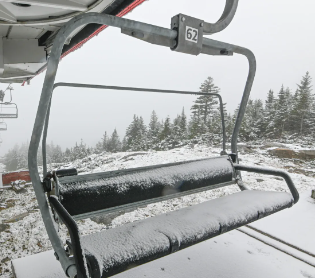PLEASE CONSIDER USING OUR CONCIERGE CUSTOM FORECASTING SERVICE FOR THE UPCOMING SEASON:
https://powderchasers.com/concierge
Powderchaser Luke here filling in again for Steve while he's out of town. This post will be exclusively cover the the two storms on tap for Utah next week. There will be additional posts covering other regions in the coming days. Stay tuned for those. Northern Utah resorts are running well below average this month, about 70% of normal. With the big storm in Southern Utah last week, that area is now well above normal. See below.

(Image courtesy of NRCS)
But that map will look much different one week from today, as two significant storms will bring some much needed heavy snowfall.
Keys to the Chase
The first of two snowstorms that will affect Utah next week will begin on Monday. By Tuesday, The Cottonwoods should be the winners with 8-16”, with Alta/Snowbird on the high end of that range. For Park City, expect 4-8” with Canyons possibly coming out on top. Farther North, Snowbasin and Powder Mountain should wind up with 5-9”, with Powder more likely on the high end of that range. Lastly, about 2-4” will fall at Sundance and perhaps a few inches at Eagle Point and Brian Head.
Right on the heels of this first storm will be another, possibly stronger storm. Less than 24 hours after the snow ends on Tuesday, it should be snowing again on Wednesday! It's still over 4 days away, but we are expecting another 1-2 FEET with this Thanksgiving storm. We will certainly fine tune this forecast in the coming days.
Long Range
Beyond the Thanksgiving storm, there are some signs that the pattern will remain active. Below is a 5 day ensemble forecast ending on December 6th, showing moderate totals for Utah.

(image courtesy of Weatherbell)
We will also take another look at the Pacifica North American Oscillation. Remember, when this teleconnection is negative, the West is typically stormy. Below you can see the PNA remains negative through this period.

(image courtesy of Weatherbell)
Details for the Weathernerds
As previously mentioned, the first storm in this 1-2 punch will affect the region starting Monday and last through Tuesday. This will be a moderate event that impacts Northern and Central Utah, resulting from a shortwave trough (area of low pressure high in the atmosphere) rotating through a broad longwave trough that begins to dig South into the intermountain West early on Monday. There are a few key aspects to this storm that will result in a solid snow event for the mountains. Although this will be a relatively fast moving trough, it will pack a solid punch with cold air, good dynamics (features in the atmosphere that will allow Utah to squeeze as much snow out of this storm as possible), favorable orographics (winds blowing from a direction that increases snowfall), and the possibility of lake effect enhancement. In the gif below, you can see the transition in the West from a ridge to a series of troughs. The first shortwave moves through, starting around frame 7, followed by a much deeper (darker blue) cut off upper level low. You've probably heard the term \"cut off low\" before. This basically means the upper level area of low pressure becomes detached from the general West to East flow. As we mentioned during the discussion of a storm back in September, the cut off low typically involves very cold air and often stalls or moves slowly once it has been \"cut off\" from the normal. This storm is no exception.

Another interesting feature with this second storm is the omega block that will setup, initially over the Pacific and then later over the continental US. You can see the Omega Block in the two images below.


These Omega Blocks involve an area of ridging (high pressure) surrounded on both sides by troughing (areas of low pressure). They tend to be stationary and limit flow around the Omega, thus the term \"Omega Block\". You can see the evolution of the first block in the gif above.
The first trough moves through fairly quickly, so we will only be dealing with this storm for 24-36 hours. A strong cold front will accompany this event, arriving around midday Monday. By 8 am Monday, 700mb (~10k feet) temperatures will be a chilly -14 C (~7 degrees F). You can see front moving through Utah below, indicated with the dashed blue line.

(image courtesy of Weatherbell)
These cold temperatures will result in high snow to water ratios, meaning we can get more snow with less precipitation. The temperatures will be very cold following this frontal passage, enough for snow in the valleys through most of Northern and Central Utah. The large scale dynamics can be seen in the vorticity map below. In order for there to be precipitation, and therefore snow, there needs to be lift in the atmosphere. In the image below, the darker colors indicate greater lift, seen throughout Utah.

(image courtesy of Tropical Tidbits)
Next, we will look at the wind direction to see what we can expect for orographic snow (when air is forced upward by terrain, cools, and then the must fall out as snow b/c the air is saturated) with this event. You will see a lot of time heights in our forecasts this season, as they are a great way to view the freezing level (what elevation the temperature is 32 degrees - the blue line), wind direction and strength (black wind barbs) at different levels of the atmosphere, the amount of moisture in the atmosphere (green colors), and many other things too. In the time height below for Alta, you can see a period of NW winds from the surface (bottom of the chart) to ~600mb (~14k feet - highlighted red box) from Monday morning through Tuesday morning. This is a very good setup for orographic snow. NW winds benefit Little Cottonwood Canyon and Powder Mountain most. This period of NW winds, cold temperatures, and a moist atmosphere following the cold front will be the biggest factor for determining snow totals.

(image courtesy of the University of Utah)
The final issue to discuss with this first round of snow is the possibility of Lake Effect snow Monday afternoon/evening. Below are three model outputs for how the Lake Effect Snow will occur from Monday evening through Tuesday. You can see both the exact location of these lake effect bands as well as the amounts are inconsistent.



(images courtesy of Weatherbell)
Should these lake effect bands set up a little farther East, over the Cottonwoods, snow totals could surpass the forecast. Lake Effect Snow is definitely a challenge to forecast, but we have included what we think will fall as lake effect into out forecast.
Well it's getting late, and we need to get this forecast out, so that's all for tonight! We're beyond excited for Utah to turn into the Winter wonderland that we love. With a few chances for valley snowfall in addition to the big mountain snow, things should look and feel quite different by next weekend. Thanks as always for reading our forecasts and supporting the site.
PLEASE CONSIDER USING OUR CONCIERGE CUSTOM FORECASTING FOR THE UPCOMING SEASON: https://powderchasers.com/concierge
Powderchaser Luke


























